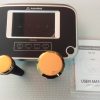- Training Manikins
- Electromedical
- ANESTHESIA MACHINES
- AUTOCLAVE STERILIZER
- Ambu Denmark
- CTG MACHINES
- DEFIBRILLATOR
- DERMATOLOGY
- ECG MACHINES
- EEG / EMG MACHINES
- ELECTRO SURGICAL UNIT
- ENT EQUIPMENT
- HOLTER AND AMBULATORY DEVICESHOLTER AND AMBULATORY DEVICES
- NEONATAL EQUIPMENT
- OPERATION LIGHTS
- OPERATION TABLE
- PATIENT MONITORS
- RESPIRATORY SERIES
- SPIROMETRY
- SUCTION MACHINES
- SYRINGE / INFUSION PUMP
- ULTRASOUND MACHINE
- LARYNGOSCOPES
- P.O.P CUTTERS
- TOURNIQUET
- X-RAY ILLUMINATOR
- MEDICAL BULB
- TEMPERATURE DATALOGGER
- RADIOLOGY
- Hospital Furniture
- Belt & Braces
- Rehabilitations
- ALUMINUM MANUAL WHEEL CHAIR
- CEREBRAL PALSY WHEEL CHAIR
- CHILDREN WHEEL CHAIR
- COMMODE CHAIR
- COMMODE WHEEL CHAIR
- ELECTRIC WHEEL CHAIRS
- PORTABLE TRAVELING WHEEL CHAIR
- ROLLATOR
- SHOWER CHAIR
- STEEL MANUAL WHEEL CHAIRS
- STICKS & QUAD CANE
- TRANSPORT WHEEL CHAIR
- WALKERS ADULT & CHILD
- ELECTRIC COMMODE LIFT
- ELECTRIC PATIENT LIFTER
- ACCESSORIES
- Surgical Instruments
- Physiotherapy
- Laboratory Equipments
- Home Healthcare
- Miscalleneous
- Medical Scrubs
- Show more
- Training Manikins

CPR Manikins
- Electromedical
- Hospital Furniture
- Rehabilitation
- Accident And Emergency

ACCIDENT AND EMERGENCY
- Training Manikins
- Electromedical
- ANESTHESIA MACHINES
- AUTOCLAVE STERILIZER
- Ambu Denmark
- CTG MACHINES
- DEFIBRILLATOR
- DERMATOLOGY
- ECG MACHINES
- EEG / EMG MACHINES
- ELECTRO SURGICAL UNIT
- ENT EQUIPMENT
- HOLTER AND AMBULATORY DEVICESHOLTER AND AMBULATORY DEVICES
- NEONATAL EQUIPMENT
- OPERATION LIGHTS
- OPERATION TABLE
- PATIENT MONITORS
- RESPIRATORY SERIES
- SPIROMETRY
- SUCTION MACHINES
- SYRINGE / INFUSION PUMP
- ULTRASOUND MACHINE
- LARYNGOSCOPES
- P.O.P CUTTERS
- TOURNIQUET
- X-RAY ILLUMINATOR
- MEDICAL BULB
- TEMPERATURE DATALOGGER
- RADIOLOGY
- Hospital Furniture
- Belt & Braces
- Rehabilitations
- ALUMINUM MANUAL WHEEL CHAIR
- CEREBRAL PALSY WHEEL CHAIR
- CHILDREN WHEEL CHAIR
- COMMODE CHAIR
- COMMODE WHEEL CHAIR
- ELECTRIC WHEEL CHAIRS
- PORTABLE TRAVELING WHEEL CHAIR
- ROLLATOR
- SHOWER CHAIR
- STEEL MANUAL WHEEL CHAIRS
- STICKS & QUAD CANE
- TRANSPORT WHEEL CHAIR
- WALKERS ADULT & CHILD
- ELECTRIC COMMODE LIFT
- ELECTRIC PATIENT LIFTER
- ACCESSORIES
- Surgical Instruments
- Physiotherapy
- Laboratory Equipments
- Home Healthcare
- Miscalleneous
- Medical Scrubs
Kinesiology Tap
₨1,200.00
Discriptions:
Kinesiology tape or Kinesiology Tape, was developed in the late 1970s by Dr. Kenzo , a Japanese chiropractor who wanted a tape that provided support but didn’t limit movement the way traditional athletic tapes do.
If you’ve watched a volleyball game or competitive bicycle race, you’ve probably seen it: strips of colorful tape splayed in patterns across shoulders, knees, backs, and abs. That’s kinesiology tape: a therapeutic tape that’s applied strategically to the body to provide support, lessen pain, reduce swelling, and improve performance.
Enthusiasts report success achieving these aims, but so far, there needs to be more research to say with certainty what taping can and cannot do.
Here’s what we know about how physical and sports therapists use it, its benefits, tips and what to know.
Kinesiology tape is really stretchy.
Kinesiology created Kinesiology tape with a proprietary blend of cotton and nylon. It’s designed to mimic the skin’s elasticity so you can use your full range of motion. The tape’s medical-grade adhesive is also water-resistant and strong enough to stay on for three to five days, even while you work out or take showers.
When the tape is applied to your body, it recoils slightly, gently lifting your skin. It is believed that this helps to create a microscopic space between your skin and the tissues underneath it.
Creates space in joints:
One small study with 32 participants showed that when kinesiology tape was applied over the knee, it increased the space in the knee joint. Trusted Source A similar study showed kinesiology tape also increased the space in the shoulder joint. Trusted Source Even though the increase in space is slight, it helps reduce the chance of joint irritation.
May change signals on pain pathways
Some physical therapists think the tape changes the information your sensory nervous system is sending about pain and compression in your body.
Dr. Megann Schooley, board-certified clinical specialist in sports physical therapy and certified strength and conditioning specialist, explains it this way:
“All of your tissues — skin, connective tissue, fascia, muscles — contain sensory receptors that feel pain, temperature, and touch. Those receptors all contribute to proprioception—your brain’s sense of where your body is and what it’s doing. Kinesiology taping creates a lift that unloads the underlying tissues. Decompressing those tissues can change the signals going to the brain. When the brain receives a different signal, it’s going to respond differently,” Schooley says.
Trigger points are a good example. Physical therapists have used kinesiology tape to lift the skin over these tense, knotted muscles. When the area is decompressed, pain receptors send a new signal to the brain, and tension in the trigger point decreases.
A 2015 study showed that trigger point pain was reduced and flexibility increased for people when kinesiology tape and manual pressure were used together.
Related products
₨3,500.00


₨46,500.00









